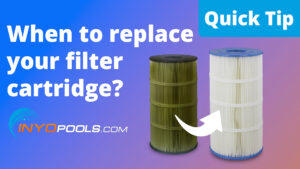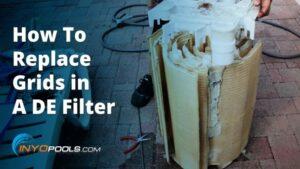By now, I think most pool owners are familiar with traditional sand filters. Sand filters have been around since forever. Okay, technically not forever, but they have been around for a very long time. In fact, the first documented use of a sand filter dates back to 1804. Although sand is the most traditional type of filter, it isn’t the most efficient. There are other filter types that leave your water cleaner but at a higher price point, of course. The love-hate relationship with sand prompted pool owners to seek alternatives to pool filter sand, but one that also works with their existing sand filter. If you’re one of those pool owners who loves their sand filter but not their sand, you’re in the right place.
Before throwing out a perfectly good sand filter, we recommend you consider the alternatives to sand. Together, let’s explore the alternatives to pool filter sand and their benefits to replacing sand in your filter.
Traditional Filter Sand
When you look through backyards today, sand filters prove to be the most popular type of pool filter. Compared to D.E. and cartridge filters, sand filters are the least expensive and  some argue that it is the easiest to maintain. One of the reasons why is because of the sand found inside the filter. For the most part, pool owners use a #20 silica sand for their filters. Each grain of sand is approximately 0.45mm-0.55 mm in size and filters around 20-40 microns. If you need a point of clarification, the diameter of a strand of human hair is approximately 60-80 microns. That’s not bad, but it certainly isn’t the best. Technically, it’s the worst.
some argue that it is the easiest to maintain. One of the reasons why is because of the sand found inside the filter. For the most part, pool owners use a #20 silica sand for their filters. Each grain of sand is approximately 0.45mm-0.55 mm in size and filters around 20-40 microns. If you need a point of clarification, the diameter of a strand of human hair is approximately 60-80 microns. That’s not bad, but it certainly isn’t the best. Technically, it’s the worst.
The most common complaint we hear about traditional sand filters is that it does not leave the pool as clear as they’d like and the sand always seems to find its way back into the pool. Those two things alone would frustrate any pool owner. As a result, pool owners and pool experts actively sought a suitable replacement for the sand. Pool owners don’t have issues with the performance of the filter itself, just with the medium inside.
What is ZeoSand?
ZeoSand, or ZeoBest, isn’t really sand at all. In fact, it is comprised of 100% natural zeolites. You typically find zeolites in volcanic rocks, which is pretty cool. ZeoSand is the  only medium that uses the ion-exchanging property of attraction to attract contaminants chemically. The shape of the ZeoSand looks like a 3D honeycomb, making it very low in density and 100 times the surface area of traditional filter sand. Because ZeoSand lays closer together than sand does, pool owners actually use less ZeoSand in their filters than traditional sand.
only medium that uses the ion-exchanging property of attraction to attract contaminants chemically. The shape of the ZeoSand looks like a 3D honeycomb, making it very low in density and 100 times the surface area of traditional filter sand. Because ZeoSand lays closer together than sand does, pool owners actually use less ZeoSand in their filters than traditional sand.
ZeoSand also filters out contaminants as small as 2-5 microns. That’s almost 10 times smaller than sand. It also traps ammonium ions responsible for chloramine formations, reducing eye irritation and odor. [clickToTweet tweet=”Not only do you use less, ZeoSand also lasts longer than sand.” quote=”Not only do you use less, ZeoSand also lasts longer than sand.” theme=”style1″] It reduces the need to backwash frequently and in turns saves you money on water consumption. ZeoSand is all- natural and environmentally friendly, too. Regular use of ZeoSand removes oils and debris, washing every grain of sand clean.
Filter Glass
Filter glass is another viable replacement for the sand in your sand filter. But what exactly is filtering glass? If you smash old pieces of recycled glass into finely crushed pieces,  you have filter glass. Each piece is smooth to touch and uniquely shaped. The shape of each piece prohibits the glass from channeling within the filter. Each filter glass has a slight negative charge. This negative charge holds onto the positively charged particles like iron and magnesium, making it excellent at removing metals.
you have filter glass. Each piece is smooth to touch and uniquely shaped. The shape of each piece prohibits the glass from channeling within the filter. Each filter glass has a slight negative charge. This negative charge holds onto the positively charged particles like iron and magnesium, making it excellent at removing metals.
Like ZeoSand, filter glass filters down to 2-5 microns and is superior in removing skin, blood cells, and 70% of all bacteria. Ultimately, pool owners save money by purchasing filter glass because not only does it require 20% less than traditional filter sand but you also backwash your filter less, saving you water and chemicals.
Filter glass is also compatible with all sanitizers, clarifiers, and metal removals.
What Are Polyballs?
Of the suggested replacement filter media, polyballs are the newest and most radical. Polyballs, or polyester balls, are used in place of sand to filter your dirty pool water.  Much like ZeoSand and filter glass, the number of polyballs you use with your filter is considerably lower than the amount of sand. Think about it, 1 lb of polyballs is equivalent to 75 punds of #20 silica sand. That’s a huge difference. Additionally, polyballs make your filter a little bit safer by providing a lower working filter tank pressure. Pool owners usually see 45% greater flow rate, as well.
Much like ZeoSand and filter glass, the number of polyballs you use with your filter is considerably lower than the amount of sand. Think about it, 1 lb of polyballs is equivalent to 75 punds of #20 silica sand. That’s a huge difference. Additionally, polyballs make your filter a little bit safer by providing a lower working filter tank pressure. Pool owners usually see 45% greater flow rate, as well.
Polyballs help your sand filter catch debris down to 5 microns. When water passes through your filter tank, the polyballs compress into a flat filter bed. They only separate once you backwash, releasing all of the dirt and debris. Polyballs are 100% recyclable and chemical resistant.
Choosing Your Alternative
If you’re a pool owner who’s tired of using traditional sand in your sand filter, don’t fret because you have options of different filter media you can replace it with. Over the last few years, I’ve seen pool owners become more interested in replacing their sand with ZeoSand, filter glass, and polyballs. Pool owners are finding success in the clarity of their pool water after switching from traditional sand. Before selecting a sand alternative, we recommend you research all three before choosing. One may be more suitable for your pool than the other. No matter what you choose, your pool is bound to see and feel the difference.












Leave a Reply